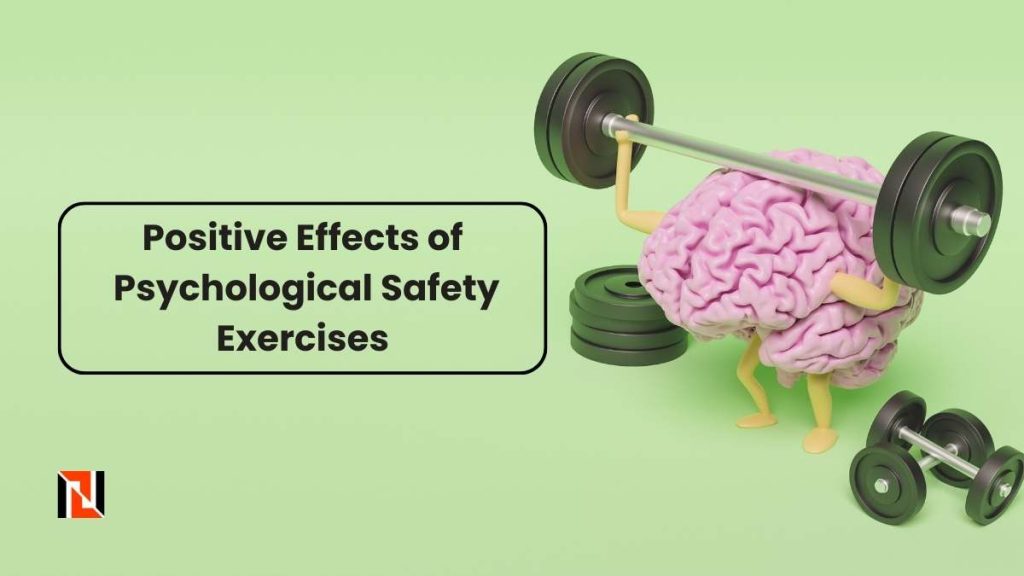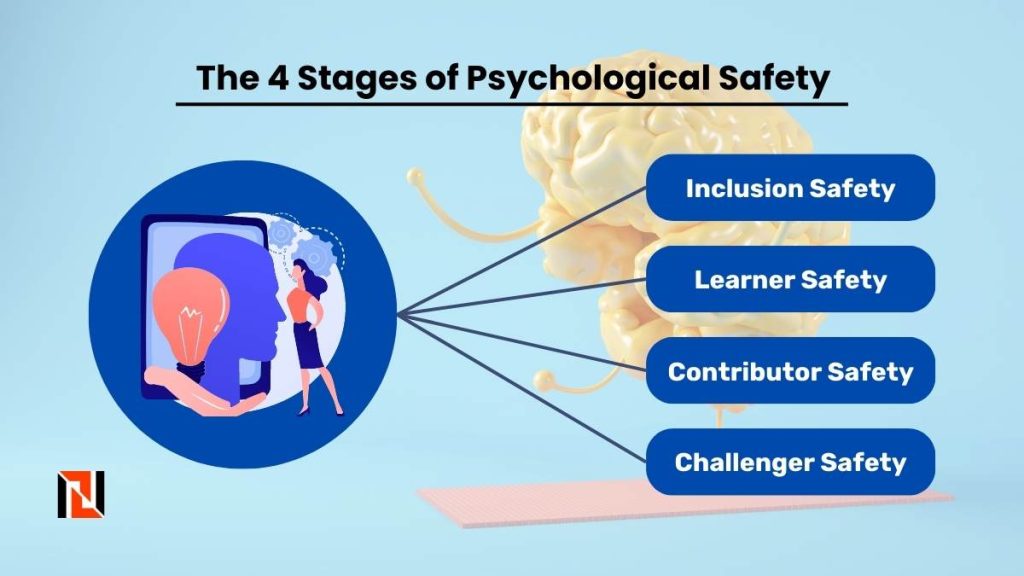As different kinds of discrimination become increasingly common, it has become clear that workplaces need to start doing psychological safety exercises. We can’t understate how much this kind of discrimination hurts our mental health, so we must take steps to counteract its harmful effects.
Psychological safety at work has far-reaching impacts. This method reduces turnover and boosts employee engagement, creating a strong company culture. Unity and cooperation create a productive, peaceful workplace. Psychological safety exercises in team-building activities produce a chain reaction that benefits the team, organization, and collaboration. This whole-person approach keeps everyone happy and healthy and strengthens the organization, making it simpler to succeed.
This initiative emphasizes psychological safety—allowing employees to openly express their opinions, develop creativity, increase self-confidence, and participate in psychological safety exercises.
The 4 stages of psychological safety, encompassing empathy, openness, inclusion, and psychological safety exercises, constitute a method that effectively addresses fundamental human safety, inclusivity, and support needs within workplaces. Devoid of these critical psychological safety exercises, individuals may falter in their ability to excel within both personal and professional spheres. This cornerstone principle underscores the notion that attending to overarching needs serves as a catalyst for fostering proactive endeavors and facilitating personal development, thereby aligning with the tenets of Maslow’s hierarchy.
What is a Psychological Safety Exercise?
Psychological safety exercises help create a workplace where people can collaborate and be themselves. These psychologically safe exercises are vital for teams that wish to develop trust, communication, and collaboration.
Psychological safety is founded on the urge to be loved and accepted. You must work at creating this kind of work atmosphere; psychological safety exercises help. Organizations can foster psychological safety by encouraging team members to ask questions, make suggestions, voice concerns, ask for support, admit mistakes, and engage in fruitful arguments. Structured exercises can help teams achieve their goal by fostering open communication, respect, and understanding.
Academically esteemed Harvard organizational behavior scientist Amy Edmondson popularised “psychological safety”. Like “The Fearless Organisation,” her seminal work defined psychological safety as team members’ common perception that their workplace is safe enough to take risks. Well-designed psychological safety exercises help teams withstand judgment and rejection. It makes people feel comfortable being honest. This climate allows people to voice what they think and question norms. This fosters growth and innovation.
Wonderful things happen when workplace psychological safety training are done well. Self-confident, collaborative teams form in these circumstances. Team members are more inclined to collaborate, share ideas, and use their abilities to achieve goals when they feel respected and heard. This synergy improves teamwork and helps members flourish by encouraging idea-sharing and learning. Psychological safety exercises provide the foundation of a strong team.
Positive Effects of Psychological Safety Exercises

Creating a psychological safety-based workplace culture benefits individuals and the company. Building trust and belonging increases employee engagement, strengthens coworker connections, and improves creative thinking and problem-solving.
The concept of the “4 stages of psychological safety” interweaves within the process of fostering psychological safety across an organization. Education of management and team leaders stands as the initial and pivotal stage, serving as a critical foundation for the successful execution of workplace activities aimed at enhancing psychological safety. These purposeful exercises not only enable teams to proactively address psychological safety challenges but also elevate their collective consciousness and purposefulness. By incorporating these exercises, teams systematically shape their trajectory towards bolstering psychological safety, ensuring the equitable recognition and appreciation of each team member’s contributions. This comprehensive approach underscores the role of diverse viewpoints in propelling innovation and cultivating a milieu conducive to achieving success.
Why are Psychological Safety Exercises so Important?
Psychological safety activities for the team are essential to our strategy. These exercises emphasize teamwork’s importance. Research suggests that professional relationships are most critical for trust, even more than first impressions. This intriguing theory claims talent assessments generally follow trust-building. Google’s Project Aristotle shows how trust builds high-performing, safe teams.
Most vital to psychological safety is trust. Trust talks and understandings may appear straightforward, but group trust takes time, practice, and dedication. We’d like to share some common trust-building exercises to assist develop a strong, psychologically safe, high-performing team. This collection includes team-approved activities, including ours, and fresh ideas to try. We provide tools and technology to assist your organization develop psychological safety.
Psychological safety activities assist team members bond and realize trust is vital. In early professional connections, trust is more vital than expertise, according to research. This is why we trust these workouts. Interestingly, trust is typically assessed before skill. The Project Aristotle findings were noteworthy because they showed how trust and psychological safety develop high-performance teams.
Making the team feel psychologically safe is intentional. Trust is essential to this path, but thinking about it won’t build it. It must be done. We’re pleased to provide several trust-building exercises that many teams employ and have worked on. Experienced exercises create a solid, psychologically safe team environment. Our collection includes exercises lauded by other teams and unique concepts. We provide information on techniques and technologies to help you achieve psychological safety.
Different Kinds of Psychological Safety Exercises

Psychological safety activities foster teamwork and growth. According to Dr. Timothy Clark, CEO of LeaderFactor and author of “The 4 Stages of Psychological Safety: Defining the Path to Inclusion and Innovation,” these activities begin with four psychological safety stages. These stages, which highlight how societal requirements vary over time, might help you build a space where people can collaborate and produce new ideas.
Inclusion Safety
The first phase, “Inclusion Safety,” helps team members collaborate. Psychological safety exercises ensure that participants can participate without fear of rejection, embarrassment, or punishment. These activities provide the group with a sense of belonging and value.
Learner Safety
Next, “Learner Safety” addresses developing a personal and professional growth environment. This stage’s psychological safety exercises make it safe to ask questions, try new things, seek feedback, and accept mistakes. These activities make self-censorship harder, making honest speech easier. This fosters innovation and calculated risk-taking.
Contributor Safety
As teams change, “Contributor Safety” becomes more important to give people freedom and trust in their contributions. In this stage, psychological safety training taps into the natural desire of people to make a difference in a project, team, organization, or community. These kinds of activities show that each team member’s ideas are important and give them the power to take charge of their projects.
Challenger Safety:
“Challenger Safety” gives people a place to disagree in a good way. In this stage, psychological safety exercises create an atmosphere where employees are encouraged to share their ideas, even if they differ from the main story. This shows that different points of view are valued and also uses different points of view to improve projects and processes.
Psychological safety training follow Dr. Timothy Clark’s stages of transformation. These activities are flexible tools for creating a peaceful, creative, and inclusive team atmosphere. They can foster involvement, learning, contribution, and constructive challenges.
Some Examples of Psychological Safety Exercises That Work
Psychological safety exercises can be adapted to fit how your team or organization works, considering things like size and culture. These exercises can be small and casual, like meeting icebreakers and team-building activities, or they can be more formal and thorough training sessions in the workplace.
Taking into account the unique circumstances of your team, here are five activities and exercises that can help build psychologically safe teams:
Make A Psychological Safety Survey
Are the ways your organization works making people feel safe? With the help of engagement surveys, you can find out how your team or organization is doing in this important area.
Start surveys that look into psychological safety. Ask team members if they think they can make mistakes, talk about tough topics, take risks, ask for help, and give constructive feedback without feeling uncomfortable or unsafe.
By using the information you get from employee responses about psychological safety, you can strategically improve your team’s overall sense of belonging and happiness. At the same time, this process sets a performance benchmark that can be used to measure future success and growth.
Talk About How to Speak Up
Looking for another way to get your team to share valuable ideas? Consider doing psychological safety exercises with your team by splitting them into smaller groups and giving them the task of developing ways to make everyone feel comfortable speaking up.
Ask these groups to think about different times in their personal and professional lives when they felt safe sharing their ideas. Encourage them to think about what was different about those situations. By compiling a list of what made those environments work well, you can start a conversation with the larger group and find out what they have in common and where they could improve. These psychological safety exercises not only get people to talk thoughtfully but also give your team the tools to help make a more open and communicative environment.
Check-Ins To Warm Up
Start psychological safety exercises at meetings to create a routine. Everyone on the team should undertake a fast pulse check. Ask them to describe their feeling as they enter the meeting in one word. You could also enquire about their day or current thoughts.
You can increase communication and create connections by focusing on team members’ well-being rather than project details. It also lets team members voice their opinions. This strategy makes your employees feel more welcome and gives you new ideas for improving collaboration. Repeating these psychological safety exercises helps build a team culture of open communication and mutual understanding.
Have an “Anxiety Party”
The idea came from a design team at Google Ventures. It is now common to practice psychological safety exercises encouraging people to be open and include others.
In this activity, people take 10 minutes to write down their biggest worries on post-it notes or index cards. Then, they spend another two minutes putting these worries in order from most important to least important. Then, each team member shares their biggest worry, and their teammates rate its importance on a scale from zero to five, with zero being “not at all worrying” and five being “strongly agree, this is an area that needs improvement.”
This structured approach lets your team talk openly about major concerns, knowing their worries won’t be brushed aside. This process encourages open communication and makes it easier to solve these worries quickly, making it the norm to deal with problems quickly.
Schedule a Sticky Note Speak-Up
The exercise we discussed before can be changed to fit almost any topic. Whether planning a project brainstorming session or laying out your team’s goals for the quarter, adding this approach to your agenda is a great way to get people to work together.
If you’re completing the exercise in person, give each team member sticky notes. Virtual whiteboards like Miro are good for distant work. Request everyone’s views, opinions, and ideas on a subject, challenge, or project. Share and compare these remarks as a group to start the next meeting’s conversation.
Using this method, you create an environment that encourages active participation, brings together different points of view, and uses the team’s collective wisdom. This method encourages creativity and problem-solving and helps team members feel like their ideas are valued and respected.
More Exercises To Improve Psychological Safety In Teams
Even though our team at Spill has used the exercises listed above successfully, many other options can help you build a psychologically safe environment. Think about adding activities like these:
The Prime Directive

A classic book’s approach to team retrospectives and feedback sessions is essential. This technique suggests starting each session with a “prime directive” reaffirmation. This creates a secure, inclusive environment for future discussions.
The first directive states, “Regardless of what we discover, we understand and truly believe that everyone did the best job they could, given what they knew at the time, their skills and abilities, the resources available, and the situation at hand.” By voicing this command, team members realize the complexity of past decisions, showing empathy, compassion, and recognition of the conditions that shape actions. This practice encourages openness and retrospection without blaming, promoting psychological safety in the team.
The ‘Snowball’ Icebreaker
This fun icebreaker is perfect for workplace training or planning day. Participants write three personal details on a piece of paper, crumple it into a “snowball,” and struggle for one minute. After a minute, everyone gets a snowball, takes turns revealing the answers, and tries to guess the owner. This exercise quickly and amusingly allows guests to share casual personal observations, creating connections before diving into the event’s more serious topics.
Make Use of Post-It Notes to Hone Your Public Speaking Skills
This idea is flexible enough for team brainstorming or meetings. Participants use sticky notes and pens to brainstorm ideas. Set a timer and ask team members to write down their topic-related thoughts, questions, and ideas. These notes are then hung.
It accomplishes numerous goals. It lets team members express their perspectives and own their ideas. Encouraging the team to ask clarifying questions sets the stage for smart dialogues. The process’s fluidity eliminates any sense of monitoring or examining individual contributions. This activity’s room movement reduces the chance of being singled out.
This method also empowers shared ideas. It’s comforting to see others’ thoughts. This affirmation might inspire those who mistrust their contributions.
Witnessing concept alignment can boost their confidence and help them express themselves in future discussions. This flexible idea encourages teamwork, idea-sharing, and confidence.
Team Effectiveness Exercise
“The Five Dysfunctions of a Team” inspired this low-risk exercise for teams of less than 10. Using psychological safety training, ask team members to secretly write down their biggest contribution to the team. Ask them to select a team-improvement area. Participants then discuss their responses. This practice will reveal surprising positive and constructive ideas despite first fears about intrusiveness. Assessing recipients’ emotional responses is crucial when analyzing these shared responses. This practice is meant to cause suffering to promote group growth over individual feelings.
Exercises for Improving Psychological Safety at Work
Not only is it essential for fundamental human decency, but also for employee retention, to cultivate working environments that are psychologically safe in order to support high-performing teams.

Check-in on Your Employees
How someone starts their workday affects how much they get done. Thus, you must check in with your employees in the morning to make them feel appreciated and heard. Meeting specialist Emily Axelrod noted that “how you enter and leave a space is just as important as what happens in the space.”
Before discussing work, ask each member to share their attitude. This is crucial to psychological safety because it allows people to be present and heard. It builds trust, lets everyone be heard, and reminds us we’re all people.
Encourage All to Speak
Talking is crucial to psychological safety. Team meetings and casual talks are usually attended by half the workforce. It could be because they feel excluded or fearful of judgment. Only 20% of most organizations lead 80% of talks. The workers should feel safe and heard.
Introverts, underrepresented groups, and new hires who stick to themselves at work gatherings are everywhere. Not only do they not want to be judged, but bigger individuals are drowning them out.
Research shows that women are harder to notice than men. The organizational psychologist examined numerous organizations and concluded that male workers who come up with a technique to make more money get better reviews than women who do the same.
A hopeful speech moves people. It can help workers stop worrying about being assessed and think creatively. It can also improve their work and mental wellness.
A Party for the Anxious
Everyone writes out their greatest concerns in the first phase. Next, everyone ranks their difficulties from most to least important.
Second, everyone shares their biggest anxiety. Colleagues rate the topic from zero (“It never even occurred to me that this was an issue”) to five (“I strongly believe you need to improve in this area”).
Most of these worries are vain, and most people worry about the wrong things. This relieves employees of significant work. However, most concerts are real and require interaction. Discuss whether it needs a group or individual approach. This should be done periodically for better results.
Be Respectful
Not only freshmen and juniors must respect seniors. Managers and juniors should respect each other. Respect, understanding, and empathy create a psychologically safe atmosphere. These attributes foster cooperation and a welcoming workplace.
Set an Example
Calling out juniors or employees for doing the same thing is unjustified. They’ll follow you, obviously. Therefore, lead by example to make employees feel protected. This includes apologizing for mistakes, communicating considerately, expressing empathy, and asking for help.
Workplace from Meta study found that 58% of UK workers would quit if leaders didn’t care for them. A healthy mind produces better output than an unhealthy one.
Empathy is Key

Frequently, we lack awareness of our colleagues’ circumstances. Both leaders and coworkers need to engage in psychological safety exercises to connect over work and personal issues. These exercises foster trust and encourage open communication. Increasing familiarity with our colleagues enhances mutual trust.
How To Apply Successful Psychological Safety Exercises
Although necessary work, providing psychological safety exercises can be difficult and must be done with care. People can find it difficult to show weakness, feel pressurised, or speak up, especially in a professional context.
Use the following suggestions to make psychological safety exercises more comfortable for everyone involved:
Establish a Culture of Trust
Create a comfortable environment for team members to exchange ideas, and remove any disruptions or distractions. Define the activity’s expectations clearly, and keep queries and conversations focused, open-ended, and non-judgmental.
Cultivate The Right Team Mindset
Team members who are open to the idea of psychological safety exercises are more likely to be found in organizations that prioritize a culture of personal and professional growth. Make it clear that your goal is to promote more cohesion and communication.
Final Thoughts
The concept at hand can be inspiring, powerful, and, at times, all that a company needs to stay on track for growth and development. Do not undervalue the significance of psychological safety exercises, and ensure that your company is well-prepared to reap the benefits that these exercises will bring to the business as a whole.


Leave A Comment